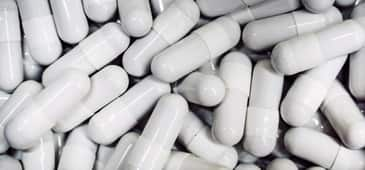
What's Hot
What's Hot
News flashes are posted here frequently to keep you up-to-date with the latest advances in health and longevity. We have an unparalleled track record of breaking stories about life extension advances.
Research suggests short term rapamycin treatment may be all that’s needed
August 31 2022. Study findings published August 29, 2022, in Nature Aging revealed long-lasting protection against some signs of aging in fruit flies and mice that were briefly treated with rapamycin, a drug that is prescribed to prevent organ transplant rejection.
While rapamycin’s effects against aging are being investigated, long term rapamycin use is may be associated with significant side effects. “We have found a way to circumvent the need for chronic, long-term rapamycin intake, so it could be more practical to apply in humans,” coauthor Yu-Xuan Lu of the Max Planck Institute for Biology of Aging announced.
In one experiment, a team led by Paula Juricic discovered that early treatment of female fruit flies with rapamycin extended lifespan and reduced age-related intestinal decline by the same amount as that obtained by lifelong treatment. Mice treated early in life also experienced lasting effects similar to those associated with treatment received throughout life. “These brief drug treatments in early adulthood produced just as strong protection as continuous treatment started at the same time,” coauthor Thomas Leech explained. “We also found that the rapamycin treatment had the strongest and best effects when given in early life as compared to middle age. When the flies were treated with rapamycin in late life, on the other hand, it had no effects at all. So, the rapamycin memory is activated primarily in early adulthood.”
“It will be important to discover whether it is possible to achieve the geroprotective effects of rapamycin in mice and in humans with treatment starting later in life, since ideally the period of treatment should be minimized,” senior author Linda Partridge noted. “It may be possible also to use intermittent dosing. This study has opened new doors, but also raised many new questions.”
—D Dye
Black tea drinkers live longer
August 29 2022. On August 29, 2022, the Annals of Internal Medicine reported a lower risk of dying from any cause during a median follow-up period of 11.2 years among men and women who regularly drank black tea in comparison with those who did not consume the beverage.
The study included 498,03 participants in the UK Biobank, a prospective study of people residing in the United Kingdom. Questionnaires completed upon enrollment provided information concerning tea and coffee intake. Eighty-five percent of the participants reported drinking tea, among whom 89% drank black tea.
During up to 14 years of follow-up, 29,783 deaths occurred. Compared to participants who did not drink tea, those who consumed 1 cup or fewer per day had a 5% lower risk of mortality and 2 to 3 cups was associated with a 13% lower risk. Tea intake was associated with decreased risks of death from cardiovascular disease, ischemic heart disease and stroke.
When participants who also consumed coffee were excluded from the analysis, comparable results were obtained. Adding milk or sugar to tea also failed to impact the results. Furthermore, the findings were valid for participants who had different genetic capacities for caffeine metabolism, which indicated that caffeine may not be responsible for tea’s protective effect.
“In this study of nearly 500,000 participants in the UK Biobank where black tea drinking was common, higher tea intake was associated with modestly lower risk for all-cause mortality and mortality from all cardiovascular disease, ischemic heart disease, and stroke, with lower risks seen for drinking 2 or more cups per day,” Maki Inoue-Choi, PhD, and colleagues at the NIH concluded. “These findings provide reassurance to tea drinkers and suggest that black tea can be part of a healthy diet.”
—D Dye
Low magnesium linked to diabetic retinopathy
August 26 2022. A study reported August 22, 2022, in Biological Trace Element Research found an association between low magnesium and a higher risk of diabetic retinopathy, a major visual complication of long-term diabetes.
“Low magnesium consumption has been linked to an increased risk of type 2 diabetic mellitus,” authors Yuan Chen of Soochow University in China and colleagues noted.
The body’s tight regulation of serum magnesium makes it a poor measure of total body magnesium status. Plasma magnesium also poorly reflects the body’s true magnesium status because of the kidneys’ reabsorption of the mineral. “The magnesium depletion score (MDS) index was recently proposed as a method of measuring magnesium shortage that took into consideration the pathophysiological factors influencing the kidneys’ reabsorption capability and was proven to be more sensitive and reliable than other clinical predictors of magnesium,” Chen and associates wrote.
Kidney function, alcohol intake, the use of diuretics and proton pump inhibitor (PPI) use affect the ability of the kidneys to absorb magnesium. These four factors are used to calculate the magnesium depletion score.
The study utilized data obtained from 4,308 men and women enrolled in the National Health and Nutrition Examination Survey (NHANES) 2005–2018. Diabetes was present in 10.7% of the participants. Dietary questionnaire responses were used to estimate the amount of magnesium consumed each day.
Greater magnesium intake and lower magnesium depletion scores were associated with a decreased risk of diabetic retinopathy. A high amount of magnesium intake was associated with a reduced risk of diabetic retinopathy when the magnesium depletion score was at a middle level or lower.
“Our research indicates that magnesium deficiency predicts a higher risk of diabetic retinopathy in diabetic individuals and that magnesium supplementation may reduce the risk of diabetic retinopathy,” they concluded.
—D Dye
Amla effects comparable to metformin in diabetes patients
August 24 2022. Findings from a study reported on August 17, 2022, in Food & Function suggest that Emblica officinalis (amla or Indian gooseberry) may be as beneficial as metformin in people with diabetes.
The study included 124 men and women with newly diagnosed diabetes and abnormal lipid levels who received 1 or 2 grams Emblica officinalis extract, or 500 milligrams metformin daily for 90 days. Fasting blood glucose, glucose after a meal and lipid profiles (triglycerides and total, HDL, LDL and VLDL cholesterol) were measured at an initial screening visit and on days 30, 60 and 90 of the study. Tests for hemoglobin A1c (HbA1c) and other blood and urine factors were conducted during screening and at the final visit.
While fasting blood glucose, post-meal glucose and HbA1c were lower in all groups at the end of the study, reductions in the group that received 2 grams Emblica officinalis extract per day were significantly greater than the decreases experienced by the other two groups.
Triglycerides and total cholesterol were reduced in all groups on day 90 with no significant differences between the groups. While LDL cholesterol was lowered in all groups, participants who received 2 grams of Emblica officinalis extract experienced a significantly greater reduction than participants who received 1 gram. VLDL declined and HDL increased in all groups, without significant differences.
“Emblica officinalis extract at a dose of 2 grams per day showed superior antidiabetic and anti-dyslipidemia activities compared to the pharmaceutical drug, metformin,” authors Muhammed Majeed and colleagues concluded. “Natural products such as standardized extract of E. officinalis is an attractive lead as a potential supplement for the management of type 2 diabetes mellitus with associated dyslipidemia since their low toxicity allows them to be used as long-term prophylactics.”
—D Dye
Chlorophyll may help people with inflammatory bowel disease
August 22 2022. A study reported on July 15, 2022, in the American Journal of Physiology–Gastrointestinal and Liver Physiology found a benefit for chlorophyllin in an animal model of inflammatory bowel disease (IBD), which includes Crohn’s disease and ulcerative colitis. Chlorophyllin is a derivative of chlorophyll, the green pigment in plants.
“Consuming green-colored vegetables or green pigment supplement such as chlorophyllin might help people with inflammatory bowel disease,” coauthor Xiaofeng Zheng, PhD, of Sichuan University predicted.
The research team induced chronic colitis in a group of mice and supplemented some of the animals’ diets with chlorophyllin in an amount comparable to that obtained by consuming 200 to 400 grams per day spinach in humans. Supplementation with chlorophyllin prevented weight loss and colon shortening while improving stool consistency and reducing blood in the stool. On the 35th day of the study, survival among mice with colitis that did not receive chlorophyllin was 40% lower than chlorophyllin-treated mice. Treated animals were found to have lower intestinal mucosal damage, inflammation and autophagy activation. (While autophagy, a process by which cells consume some of their own damaged or redundant components by degrading and recycling them, can promote cell survival, in some cases it promotes cell death.)
In mice in which acute colitis was induced, chlorophyllin or the autophagy inhibitor chloroquine similarly reduced colitis sign and symptoms and autophagic flux (a measure of the degradation activity that occurs during autophagy). “Taken together, these results indicated that persistent and provocative activation of autophagy is involved in the pathogenesis of IBD,” the authors remarked.
“In this study, we observed that autophagy in the intestinal tissue was persistently activated in IBD mice,” they observed. “Chlorophyllin, a water-soluble derivate of chlorophyll, can attenuate colitis by regulating autophagy and inflammation. Thus, consumption of green vegetables and chlorophyllin may be beneficial for IBD recovery.”
—D Dye
Pomegranate-cocoa blend helps improve aging men’s symptoms
August 19 2022. A study published on July 11, 2022, in the International Journal of Medical Science found benefits for supplementing with a combination of extracts of Punica granatum (pomegranate) fruit rind and Theobroma cocoa seed extracts in middle-aged men.
“Advancing age is a physiological progression associated with structural and functional decline in many human body organs and complemented by adaptations in behavior, physical activity, body composition, and reductions in sexual energy and endocrine functions,” Sucharitha L. Pandit of Shetty’s Hospital in Karnataka, India and associates wrote.
Previous research that investigated the effects of a blend of extracts of pomegranate fruit rind and cocoa seed in young men resulted in increases in serum and free testosterone levels as well as muscle strength and size. The current study included 120 men between the ages of 36 to 55 years who received 200 mg or 400 mg of pomegranate-cocoa extract or a placebo for 8 weeks. All participants were assigned to a program consisting of 30 minutes of walking per day for 5 days per week. Psychological, physical and sexual symptoms associated with aging were ascertained from responses to questionnaires administered at the beginning of the study and on days 7, 14, 28 and 56 of the treatment period. Hand-grip strength, perceived stress, and hormone levels and other lab tests were also assessed at these time points.
At the end of the 8-week period, both doses of pomegranate-cocoa extracts were associated with significant improvement in aging males’ symptom scores, free and total testosterone levels, strength and perceived stress compared to the beginning of the study and to the placebo group.
The authors concluded that pomegranate-cocoa “is a well-tolerated, safe, and effective nutraceutical blend that boosts sexual function, testosterone level, and psychological and general well-being in aging males.”
—D Dye
Rhodiola shows promise against diabetes in preclinical research
August 17 2022. An article published on June 22, 2022, in Scientific Reportsrevealed findings that suggest a clinical benefit for an extract of the herb Rhodiola rosea in type 2 diabetes.
“The prevalence of type 2 diabetes and the associated health costs have risen steadily in recent decades,” noted corresponding author Mahtab Jafari, PharmD, of the University of California, Irvine. “Current treatment recommendations include lifestyle changes as well as oral and intravenous medications. However, these drugs have significant limitations or side effects, increasing the need for new therapeutic interventions.”
“Humans have used plants and natural products for thousands of years to treat diseases, and our study shows Rhodiola rosea is a good candidate for further investigation,” she remarked.
In mice that were genetically modified to develop obesity, elevated blood glucose and insulin resistance to mimic human diabetes, animals that received Rhodiola rosea for 4 weeks had lower fasting glucose a week after the supplementation period in comparison with a control group that received water. Rhodiola rosea-supplemented animals also exhibited better response to insulin 2 weeks following the end of the 4-week period. Five weeks after the conclusion of the supplementation period, mice that received Rhodiola rosea showed less inflammation than animals in the control group. Analysis of the fecal microbiome at 4 time points showed differences between mice that received Rhodiola rosea and the control animals.
“Our findings suggest that Rhodiola rosea might be beneficial for treating type 2 diabetes, acting through changes in the microbiome that result in increased gut barrier integrity and decreased translocation of inflammatory molecules into the blood circulation,” Dr Jafari stated. “Gut barrier integrity influences body weight and insulin response, and this botanical product may improve the responses of liver and muscle tissues to insulin produced by the pancreas.”
—D Dye
Meta-analysis concludes benefits for selenium supplementation in cognitively impaired individuals
August 15 2022. A systematic review and meta-analysis published on August 5, 2022, in Nutrients found that supplementing with selenium was associated with improved levels of this mineral and the antioxidant enzyme glutathione peroxidase, as well as better cognitive function among patients with mild cognitive impairment (MCI) or Alzheimer disease (AD).
“For the first time, our study demonstrated, through a systematic review and meta-analysis, the possible benefits of selenium supplementation on selenium levels in patients with MCI or AD, as well as on markers of oxidative stress and on cognitive test performance,” Meire Ellen Pereira and colleagues wrote.
For their review, the researchers selected 11 controlled studies that examined the effects of selenium supplementation, alone or in combination with other nutrients, among patients with mild cognitive impairment or Alzheimer disease. Six of these studies were included in the meta-analysis.
Among studies that evaluated the effects of selenium without other nutrients, selenium measured in plasma, serum, red blood cells or cerebrospinal fluid increased among participants who received the mineral while remaining essentially the same or lower in the control groups. The meta-analysis determined that supplementing with selenium increased selenium levels by an average of 4 times in plasma, 1.88 times in serum, 3.73 times in red blood cells and 2.18 times in cerebrospinal fluid.
Studies of selenium supplementation alone that measured glutathione peroxidase revealed a significant increase in the enzyme in association with selenium supplementation. Scores of all cognitive function tests improved in groups that received selenium alone and for two of the tests completed by those who received selenium with other nutrients.
“Selenium supplementation is a good alternative for alleviating some of the symptoms of Alzheimer disease and mild cognitive impairment, such as decreased selenium levels and glutathione peroxidase activity, and cognitive deficits,” Pereira and her associates concluded.
—D Dye
Mechanism found for ability of EPA to inhibit neuropathic pain
August 12 2022. On July 18, 2022, the Proceedings of the National Academy of Sciences reported the discovery of how the omega-3 polyunsaturated fatty acid eicosapentaenoic acid (EPA) is able to help relieve neuropathic pain.
“Conventional molecular targets such as COX-2 inhibitors can explain the anti-inflammatory and analgesic effects for inflammatory pain, but not neuropathic pain, of EPA,” noted corresponding author Takaaki Miyaji of Okayama University in Japan. “However, since EPA significantly attenuates both inflammatory and neuropathic pain, there is a strong possibility that there exists another important molecular target of EPA related to neuropathy.”
“Purinergic chemical transmission is involved in neurological, metabolic, and immunological disruptions and functions, including neuropathic and inflammatory pain,” the authors wrote. “The released adenosine triphosphate (ATP) and degraded adenosine diphosphate (ADP) or adenosine binds to many types of purinoceptors that are intricately involved in biological and pathological processes.”
Dr Miyaji and colleagues hypothesized that EPA targets a vesicular nucleotide transporter (VNUT) that mediates this binding. By testing human-derived VNUT in cells, the team found that EPA competes with chlorine ions that would otherwise activate VNUT. In wild-type mice, EPA relieved neuropathic pain induced by chemotherapy but was not effective in animals that were deficient in VNUT, confirming EPA’s VNUT-inhibitory ability.
“We found that low concentrations of EPA completely and reversibly inhibited the release of ATP from neurons, without inhibiting the release of other neurotransmitters,” Dr Miyaji reported. “Compared with other drugs, EPA demonstrated a higher analgesic effect and fewer side effects.”
“Our results can help develop novel nutrient-based treatment and prevention strategies by targeting purinergic chemical transmission for inflammatory, neurological, and metabolic diseases, without the adverse side-effects of conventional pain-relieving medications,” Dr Miyaji concluded.
—D Dye
Evidence that vitamin D deficiency causes chronic inflammation
August 10 2022. An article appearing May 17, 2022, in the International Journal of Epidemiology reported the outcome of a study that found an association between genetically predicted vitamin D deficiency and a greater amount of inflammation as indicated by higher genetically predicted levels of C-reactive protein. The research suggests a causative role for vitamin D deficiency in chronic inflammation.
Authors Ang Zhou and Elina Hyppönen remarked that observational studies have uncovered an association between higher serum vitamin D and lower CRP levels; however, whether the association reflects reverse causality or confounding by behaviors such as less time spent outdoors among unwell individuals has been debated. They sought to determine whether Mendelian randomization, which uses genetic variants associated with a particular factor to approximate the factor in an analysis, would better support a causative role for low vitamin D in inflammation. “Sitting at the interface between observational studies and randomized–controlled trials (RCTs), Mendelian randomization (MR) has been increasingly used to strengthen causal evidence in observational studies,” they wrote. “MR has the benefit of reducing bias due to confounding and reverse causation.”
The study included 294,970 participants in the UK Biobank, which enrolled UK residents from 2006–2009. Blood samples collected at enrollment were analyzed for genetic information and other factors.
Genetically predicted vitamin D deficiency was associated with higher CRP levels. Analysis of the data did not support a causative effect for inflammation in lower vitamin D levels.
“High levels of C-reactive protein are generated by the liver in response to inflammation, so when your body is experiencing chronic inflammation, it also shows higher levels of C-reactive protein,” Dr Zhou explained. “This study examined vitamin D and C-reactive proteins and found a one-way relationship between low levels of vitamin D and high levels of C-reactive protein, expressed as inflammation.”
“Boosting vitamin D in people with deficiencies may reduce chronic inflammation, helping them avoid a number of related diseases,” Dr Zhou added.
—D Dye
B vitamins could help prevent advanced fatty liver disease
August 8 2022. A report published in the November 2022 issue of the Journal of Hepatology described how folic acid and vitamin B12 could reduce the progression of nonalcoholic fatty liver disease (NAFLD) to nonalcoholic steatohepatitis (NASH).
“While fat deposition in the liver is reversible in its early stages, its progression to NASH causes liver dysfunction, cirrhosis and increases the risk for liver cancer,” explained first author Madhulika Tripathi, who is a senior research fellow at Duke-NUS Cardiovascular & Metabolic Program’s Laboratory of Hormonal Regulation in Singapore.
Homocysteine is an amino acid that, when elevated, has been associated with a greater risk of cardiovascular disease, heart failure and other conditions. The B complex vitamins folic acid and vitamin B12 help maintain homocysteine at a healthy level.
The research team induced progressive NASH in mice by allowing them to consume as much as they wanted of a Western diet and fructose-enhanced water for 8, 16 and 30 weeks. They observed rising serum homocysteine levels in association with NASH progression. The increase in serum homocysteine was reflected in liver homocysteine accumulation with disease progression. Increased liver homocysteine resulted in attachment of homocysteine to several liver proteins, including syntaxin 17. This attachment blocked syntaxin from transporting and digesting fat in a process known as autophagy, which resulted in fatty liver disease progression. However, animals given folic acid and vitamin B12 had greater expression of syntaxin, restoration of autophagy and slower progression of NASH.
“Our findings are both exciting and important because they suggest that a relatively inexpensive therapy, vitamin B12 and folic acid, could be used to prevent and/or delay the progression of NASH,” coauthor Brijesh Singh commented. “Additionally, serum and hepatic homocysteine levels could serve as a biomarker for NASH severity.”
—D Dye
Vitamin K protects cells
August 5 2022. An article appearing on August 3, 2022, in Nature reported that the reduced form of vitamin K has an antioxidant effect that inhibits cell death caused by ferroptosis: an iron-dependent type of programmed cell death characterized by the oxidative destruction of cell membranes. “We identified that vitamin K, including phylloquinone (vitamin K1) and menaquinone-4 (vitamin K2), is able to efficiently rescue cells and tissues from undergoing ferroptosis,” first author Eikan Mishima announced.
Ferroptosis has been implicated in Alzheimer disease and other disorders. “Ferroptosis, a non-apoptotic form of cell death marked by iron-dependent lipid peroxidation, has a key role in organ injury, degenerative disease and vulnerability of therapy-resistant cancers,” the authors explained. “Here we show that the fully reduced forms of vitamin K—a group of naphthoquinones that includes menaquinone and phylloquinone—confer a strong anti-ferroptotic function, in addition to the conventional function linked to blood clotting.”
In previous research, senior author Marcus Conrad and his associates found that an enzyme known as ferroptosis suppressor protein-1 (FSP1) reduced coenzyme Q10 to a compound that suppressed ferroptosis. In the current investigation, they determined that the fully reduced form of vitamin K (vitamin K hydroquinone) is a strong antioxidant and prevents ferroptosis. “The reduced forms of Vitamin K and coenzyme Q10 are not very stable, so our finding that FSP1 can maintain them in their active (reduced) state is key to understanding how they are able to function to maintain cell viability,” coauthor Derek A. Pratt stated.
The team found that vitamin E and three forms of vitamin K— phylloquinone, menaquinone-4 (MK4) and menadione (vitamin K3)—rescued cells that were genetically modified to undergo ferroptosis.
Dr Conrad concluded that the findings “will serve as the stepping stone for the development of novel therapeutic strategies for diseases where ferroptosis has been implicated.”
—D Dye
Consuming enough calcium may protect against symptomatic kidney stones
August 3 2022. A study reported August 1, 2022, in Mayo Clinic Proceedings revealed a lower risk of recurrent kidney stone symptoms in men and women who had a higher intake of calcium.
"These dietary findings may have particular importance because recommendations for preventing kidney stones have been based primarily on dietary factors associated with first-time rather than recurrent stone formation," noted senior author Andrew Rule, MD. "Patients may not be likely to adjust their diet to prevent an incidence of kidney stones, but they are more likely to do so if it can help prevent recurrence."
"Changing your diet to prevent kidney stones can be very difficult," he stressed. "Thus, knowing the dietary factors that are most important for preventing kidney stone recurrence can help patients and providers know what to prioritize."
The study enrolled 411 symptomatic kidney stone formers and 384 control patients who did not have the condition who were seen between 2009 and 2018 at the Mayo Clinic. Responses to questionnaires concerning diet at the beginning of the study provided information concerning the intake of various nutrients.
During a median 4.1-year follow-up period, 73 stone formers experienced a recurrence of their symptoms. Participants who consumed lower amounts of calcium, potassium, caffeine, phytate and fluids, had a greater risk of developing recurrent kidney stone symptoms compared to participants whose intake of these dietary factors was higher.
After adjustment for various factors, low calcium remained a significant predictor of recurrent symptoms. Low potassium intake remained a predictor only among participants who were not using thiazide diuretics or calcium supplements.
“Diets with the US Department of Agriculture recommended daily intake of calcium (approximately 1200 mg) and high in potassium may be helpful for preventing both incident and recurrent symptomatic kidney stones,” the authors concluded.
—D Dye
Green tea helps support healthy glucose in metabolic syndrome patients
August 1 2022. Findings from a trial reported in the June 2022 supplement of Current Developments in Nutrition revealed that consuming green tea extract improved glucose levels in adults with metabolic syndrome: a cluster of factors that increase the risk of diabetes and cardiovascular disease. Green tea extract was also associated with improvement in intestinal health, including a reduction in leaky gut.
“There is much evidence that greater consumption of green tea is associated with good levels of cholesterol, glucose and triglycerides, but no studies have linked its benefits at the gut to those health factors,” noted senior author Richard Bruno of Ohio State University.
The trial was a follow-up to a study published in 2019 that found protective effects for green tea against inflammation induced by nonalcoholic steatohepatitis (NASH) in mice. In the current crossover trial, 21 individuals with metabolic syndrome and 19 healthy participants received 1 gram of green tea extract or a placebo for 28 days. This period was followed by another treatment period in which participants who previously received the extract were given a placebo and those who had received a placebo were given the extract.
Consuming green tea extract was associated with lower fasting glucose and markers of intestinal inflammation in comparison with the placebo. In separately published findings, green tea extract was associated with decreases in small intestinal permeability (leaky gut).
“What this tells us is that within one month we’re able to lower blood glucose in both people with metabolic syndrome and healthy people, and the lowering of blood glucose appears to be related to decreasing leaky gut and decreasing gut inflammation – regardless of health status,” Dr Bruno concluded.
—D Dye

 August 31 2022. Study findings published August 29, 2022, in
August 31 2022. Study findings published August 29, 2022, in  August 29 2022. On August 29, 2022, the
August 29 2022. On August 29, 2022, the  August 26 2022. A study reported August 22, 2022, in
August 26 2022. A study reported August 22, 2022, in  August 24 2022. Findings from a study reported on August 17, 2022, in
August 24 2022. Findings from a study reported on August 17, 2022, in  August 22 2022. A study reported on July 15, 2022, in the
August 22 2022. A study reported on July 15, 2022, in the  August 19 2022. A study published on July 11, 2022, in the
August 19 2022. A study published on July 11, 2022, in the  August 17 2022. An article published on June 22, 2022, in
August 17 2022. An article published on June 22, 2022, in  August 15 2022. A systematic review and meta-analysis published on August 5, 2022, in
August 15 2022. A systematic review and meta-analysis published on August 5, 2022, in  August 12 2022. On July 18, 2022, the
August 12 2022. On July 18, 2022, the  August 10 2022. An article appearing May 17, 2022, in the
August 10 2022. An article appearing May 17, 2022, in the  August 8 2022. A report published in the November 2022 issue of the
August 8 2022. A report published in the November 2022 issue of the  August 5 2022. An article appearing on August 3, 2022, in
August 5 2022. An article appearing on August 3, 2022, in  August 3 2022. A study reported August 1, 2022, in
August 3 2022. A study reported August 1, 2022, in  August 1 2022. Findings from a trial reported in the June 2022 supplement of
August 1 2022. Findings from a trial reported in the June 2022 supplement of 